Orion Introduction
Orion Accessories
![]() News
News ![]() Products
Products ![]() Pricing
Pricing ![]() Distribution
Distribution ![]() Notes & Interesting Articles
Notes & Interesting Articles
![]()
![]()
![]() Mounts
Mounts
![]() Telescopes
Telescopes
![]()
Atlas™ 10 EQ Equatorial Reflector Telescope
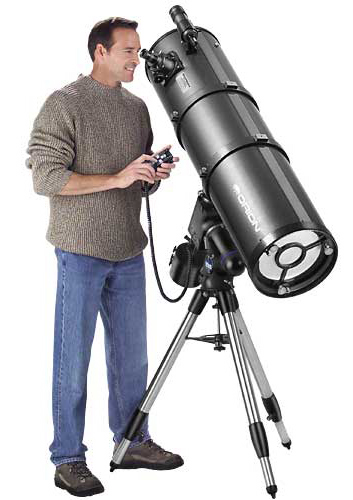 A Deep Space Sized Telescope!
A Deep Space Sized Telescope!
Right: Orion Atlas™ 10"/25cm f4.8 Equatorial Reflecting Telescope with standard 9x 50mm Finder, 2" Focuser, 2" and 1.25" Eyepiece Holder, Dual Axis Drive and Controller (80,871 Bytes).
The Orion Atlas™ 10 EQ telescope is designed for the beginner to intermediate level observer who is certain to make a commitment to then hobby. This telescope provides not only the best possible view of the faint Deep Sky objects that most people can manage sharing the optical tube assembly of its highly popular cousin, the SkyQuest™ 10 Dobsonian. But this 10 inch telescope was originally furnished with the Atlas™ German Equatorial Mount with an electronic Dual Axis Drive system thereby adding the capability to automatically track objects across the sky as the Earth rotates. By 2010 however, the Atlas™ Mount is provided only with the 'go to' computer controlled drive system.
The provided Dovetail Quick Release Hardware makes it a simple matter to attach the provided 10 inch Newtonian optical tube assembly (OTA) or other telescopes in place of the 10 inch Newtonian. So one night you could be out observing a faint galaxy and the next image a planet with a high resolution five or six inch apochromatic refractor or larger Maksutov. By 2010 we were offering an optional upgrade Saddle, this is a wider version so that our customers could more easily interchange any telescope that uses the popular Losmandy "D" series dovetail plates. This provides a much more rigid way to support telescopes as large as this 10.
These Orion telescope benefit from years of study and refinement of those Dobsonian style telescopes already on the market, they incorporate advanced design and materials to keep them lightweight and simple to use. The version of the Atlas™ mount (made in China) has been refined under the careful guidance of Orion engineers to provide uncommonly good performance. Furthermore, the accessories included are common sense items to insure a good first night out; these are items that would normally be optional for competing telescopes. All of this is engineered to put this performance into the hands of amateurs who do not wish to sell farm to buy a telescope!
Radical Resolution and Photons by the bucketful!
The Atlas™ 10 is a big telescope, for big celestial appetites! Before you buy a highly capable large telescope such as this, consider carefully its size (48" optical tube length), weight (Equatorial Mount 54 lbs., optical tube 30 lbs.) and relatively higher complexity before you buy. For simple visual uses only you may be better served to buy it's simpler cousin the Orion XT10 - 10"f4.9 Dobsonian telescope, or the lighter weight Equatorial Orion
Adjustable 2" Focuser The Atlas™ 10 OTA is provided with a 2" diameter focuser. This aluminum focuser accepts low magnification, wide field of view 2" eyepieces as well as the common 1.25" diameter eyepieces with the provided 2 to 1.25" diameter reducer. The Focuser Base Plate incorporates user adjustable set screws to facilitate collimation (aligning the optical path) of the telescope. And with an optional high quality low magnification eyepiece, one could reach 23X observing areas as large as 2.1 degrees across! Keep in mind that at such a low magnification the Exit Pupil (the diameter of the cone of light coming out of the eyepiece) is 11.13mm and so this may not be as good a choice as using an eyepiece that provides 36X showing 1.77 degrees with a 7.08mm Exit Pupil. If this telescope were equipped only with a 1.25" focuser, then the maximum Field of View would be only 1.23 degrees at 31X - but with 8.1mm Exit Pupil; a more practical 32mm eyepiece would provide 1.23 degrees at 39X with a more practical 6.48mm Exit Pupil; please feel free to contact or visit Company Seven by phone or Email for suggestions that would be best suited to your goals.
The factors of aperture and the 2" focuser are particularly important to people who seek better views of the extended, and faint deep sky objects (nebulae, star clusters, galaxies, comets, etc.). In effect the stellar magnitude reach is extended from about stars of magnitude 13.8 of an 8" telescope to 14.3. And still this telescope affords the contrast and clarity qualities required to observe the moon, and planets where the Atlas™ 10 actually reveals changes through out the observing season! With a comparatively small central obstruction, and with fewer optical surfaces, the contrast and brightness can actually surpass several more expensive designs including some 8" and 10" Schmidt-Cassegrain telescopes.
What characterizes a reflecting telescope? The Optical Tube Assembly (OTA) is an arrangement of the classic Newtonian reflecting telescope. An English mathematician originated this optical design although Sir Isaac Newton first made it. This system employs two mirrors. The Parabolic "Primary" mirror is the factor by which most telescopes are described; hence an 10" telescope has a primary mirror of 10 inch (25cm) in diameter. The Primary mirror of the telescope is precisely mounted in a Cell at the rear of the telescope. The light entering the telescope is gathered and then reflects forward in a converging beam, to the Secondary Mirror that is positioned near the front of the telescope. The light from the Primary mirror is then reflected out to the side of the telescope achieving focus at a point beyond the focuser. An eyepiece to enlarge the image for viewing, or a camera for photography is placed at the focuser.
Left: Pyrex® Parabolic Primary Mirror of an Orion Dobson telescope in it's Cell (16,559 bytes). Click on image to see enlarged view (68,383 bytes).
In a departure from most modestly priced imported reflecting telescopes, the Primary Mirror of the Atlas™ 10 is made of Pyrex®. The American firm Corning Incorporated developed Pyrex® a well proven material which has been marketed since 1915. Pyrex® is a sophisticated borosilicate glass composition made of Silicon, Boron, Sodium and Aluminum. It provides good chemical, thermal, mechanical and optical properties. Its density (g/cm3) is 2.23. This material can be polished to provide and hold a high quality of view, and provides stability and optical performance better than mirrors in most telescopes sold anywhere near this price range. Continuing its tradition of innovation and product improvement, Orion chose to make the change from Borosilicate crown glass to Pyrex® for their XT-10 Dobsonian in October 2002 and Pyrex® is the choice for the new Atlas™ 10 too.
Among the considerations of a reflecting telescope is that the mirrors be precisely positioned within the OTA in terms of centering, tilt, and spacing. The overall alignment ("collimation") of the one optical element to the other, and their placing the focal plane (the point where the image comes to focus) at the correct position beyond the focuser are critical. The optical axis of the telescope should be closely parallel to the mechanical axis of the tube assembly too. Company Seven chose Orion's telescopes in part because of their consistently good quality mechanical components and assembly at the factory that facilitate collimating these telescopes precisely upon delivery, if needed.
In their effort to produce a telescope that is east to collimate, not only are the usual adjustment devices provided to adjust the Primary and Secondary mirror but the center of each Atlas™ 10 Primary Mirror is marked with an indicator, and the 2" Focuser Base is adjustable to facilitate collimation by even the most inexperienced persons! Incidentally, since the Center Spot is located at the center of the Primary in an area obstructed by the Secondary Mirror, this mark has no adverse impact on the performance of the telescope.
A well made reflecting telescope can offer the best view per the dollar of the faint, deep sky objects where light gathering power is essential. Light gathering power increases are more important and come quicker than one may think; consider that a 6"f8 reflecting telescope has an overall length of 48" (121cm), yet this may show objects about 335X fainter than the unaided eye. While the Atlas™ 10 (with similar physical length) provides about 900X the light gathering power over the unaided human eye - in astronomy size can matter!
The Orion Atlas™ German Equatorial Mount:
The Orion Atlas™ mount is made in China to a specification set forth by Orion. Historically, Company Seven hesitated to offer economical products from China since the telescope manufacturing industry has been inconsistent in its infancy, even at its best it could not rival japan or Taiwan and other sources. Up to the end of the 20th century we considered China to be where Japan was in the 1950's when "Made in Japan" was synonymous with inexpensive and modest quality products. However, China over the 1990's invested more and more to rapidly improve its manufacturing infrastructure. We studied and later elected to offer several good Chinese made telescopes including the SkyQuest™ Dobsonian and the StarMax™ 127 Maksutov-Cassegrain telescopes. When in the Fall of 2002 we observed a highly anticipated state of the art computer graphics video card (ATI Radeon 9700) arrive bearing the label "Made In China", this reinforced our belief that China had arrived as a commercial force. Similarly, when we first heard of a mount similar to the Atlas™ being offered by some other distributors we were skeptical. After all, some were claiming this would be the $1,000 Chinese version of the $2,300 Losmandy G-11. In reality, the Atlas™ is not a highly sophisticated mount like our Losmandy G-11, but at the price this mount can be offered by Company Seven and Orion (with the engineering and support improvements by us both) the Atlas™ becomes a phenomenal value for what it can do - at prices not seen since before the days in the mid 1980's when the Reagan administration devalued the US Dollar against the Yen making previously affordable Japanese products as costly as those made in the USA.
Advantages of German Mounts If you seek to observe the planets or do other operations which require high magnifications, or if you wish to share the telescope with several others or children, or if you hope to become involved in astrophotography then we do suggest you place the telescope onto a German Equatorial mount that will provide a much easier capability to stay on a target in the sky.
The German mount arrangement has advantages over the fork mounted designs in that:
The Orion Atlas™ mount is a good value in terms of the payload capacity, provided accessories and electronics. For the money spent little else in its class can rival it for visual use; it can manage Schmidt-Cassegrains as large as the Celestron C-11, refractors as large as a five or six inch Apo. However, if you seek a mount for more advanced applications, or one that can grow with options including "go to" computer control then you may instead buy a telescope optical tube and mate it to a more capable mount such as our Losmandy G-11. Or you may consider the Orion Atlas™ as your first mount on which to learn your way around the night sky, and later upgrade to a more sophisticated mount.
The Motion The German Equatorial Mount is designed to facilitate gradually turning a telescope in the opposite direction from that which the Earth is rotating, at the same apparent speed as the Celestial objects are moving. The motion is so slow that few people can observe the motion, this rotation is only on the order of one revolution per 24 hours! To track precisely, the Right Ascension Axis of the German Mount is adjusted by the user so that the axis is parallel to the rotational axis of the Earth. An equatorial mount will provide acceptable results for visual uses if the mount is aligned to within about one ot two degrees of the Celestial Pole. But as you align the Mount more and more accurately then the need to periodically make minor adjustments to center a target in the eyepiece will become less frequent. A very accurately alignment of the mount to the Celestial Pole is most beneficial for those persons who intend to attempt astrophotography or CCD imaging.
Right: Orion Atlas™ Equatorial Mount R.A. Axis housing showing furnished integral Pole Alignment Finder Telescope. Click on image for enlarged view (161,287 bytes).
Pole Finder Telescope Astronomers often use a Pole Alignment telescope in a German Mount as an aid to quickly orient the German Equatorial Mount R.A. Axis onto the Celestial North or South Pole. The Orion Atlas™ Equatorial Mount includes a Pole Finder as a standard accessory. The eyepiece of this small telescope incorporates a reticle pattern that aids Pole alignment of the Mount in both and the Northern and Southern hemispheres. If setting up a telescope in a permanent location, then other techniques can be used to gradually "zero in" a mount onto the Pole to obtain even greater accuracy. However, the Pole Finder is an especially desirable aid to quick alignment for people who are transporting the mount from one location to another. The Atlas™ Polar Alignment Finder telescope is provided threaded into the mount head R.A. Axis shaft. For transport the Pole Alignment Finder is protected in a well fitted hard plastic thread on cover as it protrudes visibly from the mount head and would otherwise be vulnerable to (at the least) misalignment from impact damage.
Left: Orion Atlas™ Equatorial Mount R.A. Axis housing showing furnished integral Pole Alignment Finder Telescope. Click on image for enlarged view (161,618 bytes).
Easy to Use: The Equatorial Mount is not the most intuitive arrangement to the novice. But once the telescope is slipped into place, with counterweights added and balancing done in both axes done, and the mount Pole Aligned, with a little practice the system is then easy to use. The German Mount has two perpendicular axes called the Right Ascension (RA, or Polar) and Declination (Dec) axes. When the RA axis is aligned parallel with the Earth's rotational axis, objects can be easily "tracked" as they drift across the sky (due to Earth's rotation) by turning just one axis (RA) instead of two, as is required with an altazimuth mount. You point the telescope onto an object by simply nudging the tube up or down, and left or right by hand. Once centered onto an object, the provided electronic "Clock Drive" keeps the telescope moving with the object across the sky. And with the ability to track in Right Ascension comes the electronic capability to make fine adjustments in Declination too, since this is a "dual axis" drive system.
The telescope will swing from one side of the mount to another as once proceeds to explore the four quadrants of the hemisphere, this may at times put the eyepiece at an uncomfortable position. However, the paired clamp style Mounting Rings can be loosened so that one may rotate the optical tube to position the Focuser and Eyepiece at more convenient positions.
The motion on both axes is regulated by clutches which can be adjusted to "buttery smooth" letting you guide the telescope with just the lightest touch from one part of the sky to another.
The Atlas™ Equatorial Mount incorporates three inch diameter Setting Circles. These circles are engraved with numbers corresponding to the two dimensional "Right Ascension" (R.A.) and "Declination" (Dec.) coordinate systems used by astronomers to navigate the night sky. These help you to learn about the Celestial Coordinate System, and help you to locate objects in the sky by their cataloged coordinates. Company Seven also does offer optional electronic Encoder and digital display devices as aids to celestial navigation which can be added to the Atlas™ however, most of our customer do not buy these add-ons since they enjoy the thrill of discovery as they learn to "Star Hop" from one object in the night sky to another.
Noteworthy features of the Atlas™ 10 include:
Optical Tube Assembly Innovative Design!
Atlas™ Mount Highlights
"Starry Night Special Edition" is a basic version of the more capable "Starry Night" version 5.0 astronomy software series; this software will help you learn the night sky, see what is up day or night, now or in past millennia, plan your observing sessions, and print out charts and information about the celestial wonders. The set also includes "SkyTheatre", a DVD by Imaginova so your television or PC becomes a spaceship on a voyage through our Solar System. The set is compatible with both Macintosh computers running OSX version 10.3 or later, and with Windows XP for PC. Your personal planetarium and guide to the night sky!
Left: CD-ROM "Starry Night Special Edition" with bonus "SkyTheatre" DVD suite (43,322 bytes).
Right: Orion Atlas™ Mount shown with counterweights installed, Hand Control Box, and at minimum height with tripod legs in retracted position (23,068 bytes).
Effective Light Gathering Power:
Weight of Optical Tube Assembly:
Tripod Leg Extensions Length:
30 lbs. (13.6 kg)
24-1/4 inches / 61.6cm
29 inches / 737cm
50 inches / 127cm
67-1/2 inches / 172cm
For additional information about the Orion Atlas™ 10 Equatorial Reflecting telescope
Or for information about the Atlas™ Equatorial Mount alone download
the Orion illustrated instruction manual from Company Seven's Library.
SUGGESTED ACCESSORIES
These are optional accessories that are not included with the telescopes that we highly recommend for your viewing pleasure and long term success:
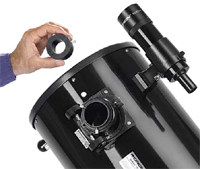 Left: Orion 2" Focuser with 2" to 1.25" reducer shown on black XT-10 optical tube - similar to the Atlas™ 10 only the OTA color differs (23,649 bytes).
Left: Orion 2" Focuser with 2" to 1.25" reducer shown on black XT-10 optical tube - similar to the Atlas™ 10 only the OTA color differs (23,649 bytes).
Click on image to see enlarged view (84,638 bytes).

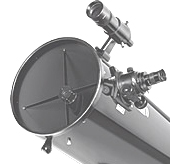 Right: Orion XT-10 Dobsonian, similar to the Atlas™ 10, showing: Secondary Mirror holder, four vane Spider, adjustable Aluminum 2" Focuser with Eyepiece, 50mm finder. Note the Navigation Knob provided with the XT-10 is not needed or provided with the Atlas™ 10. (17,089 bytes).
Right: Orion XT-10 Dobsonian, similar to the Atlas™ 10, showing: Secondary Mirror holder, four vane Spider, adjustable Aluminum 2" Focuser with Eyepiece, 50mm finder. Note the Navigation Knob provided with the XT-10 is not needed or provided with the Atlas™ 10. (17,089 bytes).
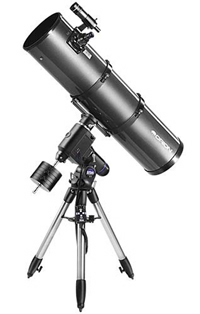 Left: Orion Atlas™ Equatorial Mount showing adjustable Aluminum Field Tripod. Click on image for enlarged view (146,820 bytes).
Left: Orion Atlas™ Equatorial Mount showing adjustable Aluminum Field Tripod. Click on image for enlarged view (146,820 bytes).
Payload capacity ratings of telescope mounts vary with quality of construction and component. Since there are no industry wide standards for determining load capacity, the factory rating alone is not a reliable predictor of performance. Factors that will affect suitability include static load, payload length (torque), tracking accuracy, tripod or pier resonance's, etc. What is most important to the user of the product is 1. how rigidly the mount holds the payload, 2. how smoothly it tracks (the periodic error amplitude and smoothness of a gear set and its support bearings), and 3. how the mount drive system overcomes the moment imparted by the load. These variable will vary with weight of the OTA, and the physical length of that load. The weight put onto a mount can also vary depending how the instrument is to be used, for example one telescope used for visual work only may be as much as 50% lighter in weight than another employed for imaging (possibly with guide scopes, cameras, etc.). The useful capacity of the mount may also vary with local winds since even a slight wind on a large "sail" area (such as that of a large reflecting telescope) can dramatically increase the effective load imparted to the mount. So, a small mount operating from within a Dome might perform as well or better than a larger mount outside a sheltered environment.
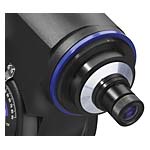
 The Atlas™ 10 Field Tripod Leg Spreader Bar incorporates a convenient Eyepiece Holder. This can hold up to five 1.25 inch and two 2 inch diameter eyepieces or other similar diameter accessories. Furthermore, this tray is held in place by two keyhole shaped screw holes so that customers may easily slide the tray up and out to remove the tray for transport or if desired. To keep dew or other contaminants from marring eyepieces set on this tray Company Seven suggests you keep eyepiece caps in place and consider the use of dew prevention devices including our Kendrick heaters.
The Atlas™ 10 Field Tripod Leg Spreader Bar incorporates a convenient Eyepiece Holder. This can hold up to five 1.25 inch and two 2 inch diameter eyepieces or other similar diameter accessories. Furthermore, this tray is held in place by two keyhole shaped screw holes so that customers may easily slide the tray up and out to remove the tray for transport or if desired. To keep dew or other contaminants from marring eyepieces set on this tray Company Seven suggests you keep eyepiece caps in place and consider the use of dew prevention devices including our Kendrick heaters.
A set of accessories provided to get you up and running on the first night out!
when making drive corrections while pointing to all quadrants of the night sky
and learn how use the celestial coordinate navigation system developed for astronomy
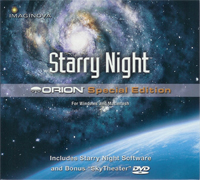 Receive a FREE Starry Night Special Edition software suite. Both the highly acclaimed planetarium software by Imaginova "Starry Night Special Edition" with a bonus "SkyTheatre" DVD are included FREE with purchase of any Orion-brand astronomical telescope from Company Seven.
Receive a FREE Starry Night Special Edition software suite. Both the highly acclaimed planetarium software by Imaginova "Starry Night Special Edition" with a bonus "SkyTheatre" DVD are included FREE with purchase of any Orion-brand astronomical telescope from Company Seven.
Click on image to view enlargement (85,180 bytes).
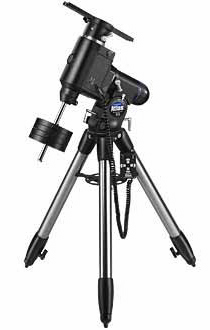 Telescope and Mount Specifications:
Telescope and Mount Specifications:
* Specifications are subject to change without notice.
Tripod with Extensions Retracted:
Magnitude Limit Visual:
Length of Optical Tube Assembly:
O.A. Diameter of Optical Tube Front Cell:
Focuser Design:
Drawtube Travel:
Weight of Equatorial Mount:
Weight of Counterweights (ea):
Height of Tripod to Mount Head
Tripod with Extensions Extended:
Height Overall (aligned 40 Deg. latitude):
Working Height to the Eyepiece:
Height of Tripod to Mount Head
Height to Saddle Center at 40 Degree Latitude, Pole Aligned
About 900X that of Human Eye
About 14.3
47-3/4 inches / 122cm
12-1/8 inches / 30.8cm
Rack and Pinion
1.5 inches (38mm)
54 lbs. (24.54 kg.)
11.9 lbs. (5.4 kg.)
68 inches / 173cm
60 inches / 152cm (to Zenith)
feel free to download the Orion illustrated instruction manual from Company Seven's Library.
Note: download size is 885,241 bytes (in Acrobat Reader ".pdf" format).
This download size is 538,422 bytes (in Acrobat Reader ".pdf" format).
 David H. Levy Guide to the Stars Planisphere If you are not familiar with the night sky then Company Seven recommends you buy a good simple Planisphere which makes it very easy for one to find out what constellations and major deep sky objects are overhead at any given time of the day or night.
David H. Levy Guide to the Stars Planisphere If you are not familiar with the night sky then Company Seven recommends you buy a good simple Planisphere which makes it very easy for one to find out what constellations and major deep sky objects are overhead at any given time of the day or night.
The night sky is mapped with the Constellations being those patterns recognizable to man since time immemorial. Constellations can be thought of as countries or states on a world map, where if you seek the Grand Canyon then you know to find Arizona. While in the night sky when one seeks the Great Nebula then one looks toward the Constellation Orion. The Planisphere is a two piece assembly consisting of one disc with a chart of the entire night sky, and an attached overlay disc with a transparent window and surrounding mask to simulate the horizons. The overlay is dialed to line up its local time indicator marks with the Month and Day printed around the edge of the chart disc, and so when properly set this will reveal what parts of the sky may be seen at any time of the year. The print is easy to read under day or red light.
 Once you begin to understand the way the night sky works with your Planisphere, the next step we suggest is to buy the Orion DeepMap 600 folding laminated Star Chart, edited by Steve Peters. Originally printed in 1997, the revised "Orion DeepMap 600" is among those indispensable publications that Company Seven recommends to anyone interested in learning their way around the night sky. The editor Steve Peters conceived of this as a very helpful device for anyone interested in astronomy and who may little or no observational experience. This has become the most popular chart of the night sky among our customers who are new to the hobby and who buy a telescope or binocular and now seek out what to see and when. This is often bought as a economical but valued and durable gift.
Once you begin to understand the way the night sky works with your Planisphere, the next step we suggest is to buy the Orion DeepMap 600 folding laminated Star Chart, edited by Steve Peters. Originally printed in 1997, the revised "Orion DeepMap 600" is among those indispensable publications that Company Seven recommends to anyone interested in learning their way around the night sky. The editor Steve Peters conceived of this as a very helpful device for anyone interested in astronomy and who may little or no observational experience. This has become the most popular chart of the night sky among our customers who are new to the hobby and who buy a telescope or binocular and now seek out what to see and when. This is often bought as a economical but valued and durable gift.
Fully color illustrated, it is the first-ever star chart that folds up like a road map! DeepMap 600 shows the positions of more than six hundred of the finest celestial objects visible from the Northern Hemisphere. Each of these objects are plotted on a giant 33 x 21 inch full-color star chart by world-renowned celestial cartographer Wil Tirion. But what really makes this star chart invaluable is its convenience; it folds "accordion style" into a thin, pocket-size 4-¾ x 10-½ inches format - just like a road map!
The chart is easy to read, and you will see more of the night sky when reading this with an optional red flashlight

- Low magnification: for views of the faint deep sky objects a 31mm to 35mm focal length eyepiece.
- Middle Magnification eyepiece - usually between 80 to 120X, for views of the full Moon, Star Clusters, etc.
- High magnification: 200X or more for views of the planets
On telescopes as fast as this system is, the relatively simple eyepiece designs including the Plossl and Orthoscopic are acceptable by most amateurs. If you object to less than perfect images particularly at the edge of the field, and if you require long eye relief (distance from lens to the eye) to accommodate spectacles, then Company Seven recommends eyepieces of advanced designs such as those pioneered by Al Nagler, founder of the TeleVue company. TeleVue's advanced designs include the "Nagler", "Radian", or "Panoptic" series eyepieces. These oculars will provide the widest clear, and flat field images bringing out the most in your telescope (and many other) telescopes. Wider field of views are also desirable since as the Earth rotates and objects drift across the field of view, a wide angler ocular shows an object for some time longer before having to adjust the telescope to compensate for inaccuracies of Pole Alignment.
Please refer to the brochure and the test report/data from Company Seven enclosed with our telescopes for detailed characterizations of suggested eyepieces:
| Eyepiece | Magnification | Actual field of view | Exit pupil |
|---|---|---|---|
| 40mm Plossl | 31x | 1.23 degrees | 8.10mm |
| 35mm Panoptic | 36x | 1.77 degrees | 7.08mm |
| 31mm Nagler | 39x | 1.99 degrees | 6.48mm |
| 32mm Plossl | 39x | 1.23 degrees | 6.48mm |
| 25 Plossl (included) | 50x | 0.90 degrees | 5.06mm |
| 17mm Nagler | 74x | 1.11 degrees | 3.44mm |
| 15mm Plossl | 84x | 0.58 degrees | 3.04mm |
| 12mm Radian | 105x | 0.58 degrees | 2.43mm |
| 9mm Plossl (included) | 139X | 0.35 degrees | 1.82 mm |
| 6mm Radian | 209x | 0.29 degrees | 1.21mm |
The telescope is available packaged as delivered from Orion, or assembled then tested and precisely collimated by Company Seven's experienced staff. While delivery is available, we suggest pickup in our showroom followed by attendance at our complimentary course of instruction. And of course the Orion One Year Limited Warranty is complimented by Company Seven's own guarantee and service facilities. With proper use and maintenance, there is very little that can go wrong with a telescope such as this.